Bengali cuisine
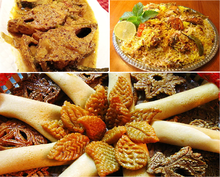
Bengali cuisine (Bengali: বাঙালি রন্ধনপ্রণালী) is the culinary style of Bengal, that comprises Bangladesh and the Indian states of West Bengal and Tripura.[1] The cuisine has been shaped by the region's diverse history and climate. It is known for its varied use of flavours including mustard oil, as well as the spread of its confectioneries and desserts.[2] There is a strong emphasis on rice as a staple,[3] with fish traditionally the most common protein. Freshwater fish are preferred to seafish, although barramundi, known as bhetki, is also common.[4] Meat is also a common protein among Bengalis with chicken and mutton meat being the most popular. Beef is popular within the muslim community. In more recent times, lentils have begun to form a significant part of the diet.[5] Many Bengali food traditions draw from social activities, such as adda, Mezban, Eid feast.

Culinary influences
Mughal influence
Muslims conquered Bengal around the mid-thirteenth century, bringing with them


In Bangladesh, this food has become common fare for the population while in West Bengal, they have remained the food of professional chefs. Further innovations include chap (ribs slow cooked on a tawa), rezala (meat in a thin yogurt and cardamom gravy) and kathi roll (kebabs in a wrap).[8]
The Mughals had a particular fixation on meat, bringing mutton and beef into mainstream Bengali cuisine as well as already known kinds of meat like chicken and venison.[7]
Furthermore, traditional desserts had been primarily based on rice pastes and jaggery, but under Mughal influence moved towards significantly increased use of milk, cream, and sugar along with expensive spices such as cardamom and saffron.[7]
Influence of widows
In Hindu tradition, widows were not allowed to eat foods that would not be classified as "bitter", necessitating experiment and innovation.[9] While most Bengali castes ate meat and fish, this was barred for widows. Widows also could not use "heating" foods such as shallot and garlic, but ginger was allowed. This style found a core place in Bengali curries in general, both vegetarian and non-vegetarian. Expensive spices such as saffron, cinnamon or cloves were used very sparingly—if at all. Nuts, dry fruits, milk and milk products (such as cream, ghee or curd) were similarly scarce.[10] These economic and social restrictions influenced Bengali widows to create a brand new set of meals that utilized only vegetables and cheap spices.
Partition of Bengal
The large-scale displacement along religious lines as a result of the partition led to changes in meal-taking, so as to adhere to religious restrictions. In Bangladesh (former East Bengal and East Pakistan), Mughlai food is common, and includes foods that are less popular in West Bengal, such as beef kebab. Additionally, sweets such as zarda and firni-payesh are eaten. In rural Bangladesh, many people eat makna fried, popped, or raw.[11][12]
During the colonial period, many Western food shops were established in Kolkata, making puff pastries, channa, chocolate, and chips especially popular. Dishes such as chop, gravy cutlet, sponge rasogolla, and ledikeni.[11] As a result of a multi-cultural community, Kolkata city's cuisine continuously changes, and takes heavy influence from Chinese and European palates.[12][13]
Characteristics
Bengali cuisine can be subdivided into four different types of dishes: eatables (খাদ্য, ভক্ষ্য, or ভোজ্য); চর্ব্য, chôrbyô, or chewables, such as rice or fish; চোষ্য, choshyô, or suckables, such as ambal and tak; লেহ্য, lehyô, or lickables, like chutney; and পেয়, peyô, or drinkables which includes drinks, mainly milk.[14]
Regional specialties
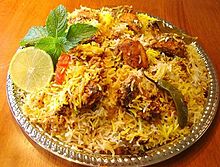
Different parts of Bengal are famed for certain dishes, food items and ingredients. For example,
Chittagong
Chittagonian culinary tradition is mostly known for Mezban and mixed rice dishes like kala bhuna, which has shoulder pieces of beef and traditional spices. Dried fish (shutki) is more available in the Chittagong region than in other parts of Bengal.[15]
Mezban
Mezban (locally known as Mejjan) is the Bengali word for special occasion feasts in the
Beef-based dishes are preferred by Bengali Muslims and are a symbol of social prestige for a Mezban feast.[17] The rich and the poor arrange feasts on various occasions as much as circumstances allow them. It has a distinct style of cooking and proper Mezban meat demands a certain skill;[17] for example:[16] The unique beef curry served in this feast is known as Mezbani gosht, that carries a distinctive recipe, knowledge of which is essentially confined within the Chittagonian cooks.[18]

Fish is used instead of beef while cooking Mezban in Hindu tradition. The Hindu community of Chittagong organises Mezbani each year under the banner of "Chittagong Parishad", with curries made from fish, vegetable and dried fish.[16]
Dhaka
Dhakaiya food is one of the most notable regional cuisines. The rich culinary customs are influenced by
Old Dhaka boasts a variation of the famous
Kolkata


In Kolkata, many local street vendors own small shops from which they sell their own homemade goods.
Influences
During the 19th century many Odia cooks migrated to Bengal to work in the households of affluent Kolkata families. They were also hired to cook in weddings and other family ceremonies. Introduction of Odia cooks into their kitchens brought in subtle but significant changes to Kolkata's cuisine. Many of Kolkata's classic dishes were originally from Odisha but were refined in Kolkata kitchens by Odia cooks. In fact some researchers say that dishes like kanika (Bengali mishti pulao) were first introduced to Kolkata kitchens by Odia cooks although this is contested by other researchers.[31][32] Even to this date most of the cooks in Kolkata kitchens and hotels are Odia cooks.[33]
The
Calcuttan immigrants to other countries have started carrying this abroad as well;[35] Indian Chinese restaurants have appeared in many places in the United States and UK.[37]
Indian Chinese food has been given a second boost in popularity since the 1950s when a large number of Tibetans migrated into Indian Territory, following the 14th Dalai Lama's flight.[38] Tibetans brought their own taste preferences to add to the genre, such as the popular momo (a kind of dumpling) or thukpa (a hearty noodle soup). Tibetans and Nepali immigrants found ready employment in the many kitchens that can now be found on virtually every street in Kolkata.[39][40]
Adda
Adda (Bengali: আড্ডা) is a traditional Bengali means of socialising over food during the work day. Food taken during adda consists usually of mishti or sweetmeats, tea, and coffee, although heartier meats such as fried fish may be brought out as well.
The adda saw a rise during the colonial era among the Bhadralok guild members to meet and talk about a range of topics:[41]
"You could be discussing Charles and Camilla's marriage this moment, and the next moment you're swinging over to the latest cricket series between India and Pakistan, and then swing back to the recent controversy over Tagore."[42]
Being a hobby for artisans, women were largely secluded from adda, a sentiment that has begun to disappear with the democratization of adda and women occupying a larger space in social life. For this reason, adda was seen as a refuge "...from the home, a neutral rendezvous away from both the perceived drudgery of the workplace and domesticity".[41]
In the post-colonial era, the adda has been fading due to the more rigid structure of work and exploitative perceptions of unnecessary laziness. This has inspired a sizeable movement of Bengalis who believe it integral to the idea of lyadh, or doing nothing to relax and recharge.[41] However, adda does still exist, being attended during vacation time or after work at clubs or coffee shops. The tradition even has an equivalent to the Greek symposium, as students may meet for a study session over food or have a teacher teach in a more relaxed environment.[43]
Sylhet
During the British period, biscuits and
-
A softer style ofkhichuri is consumed in Sylhet.
-
Seven Color Tea
-
Lotar Shutki Shira (fermented fish curry)
-
Chicken tikka masala was said to have been invented by a British-Bengali chef from Sylhet.
Utensils



Bengali food is often served on plates which have a distinct flowery pattern often in blue or pink. Another characteristic of Bengali food is the use the boti (also called dao or da). It is a long curved blade on a platform held down by one or both feet; both hands are used to hold whatever is being cut and move it against the blade, which faces the user. This method gives effective control over the cutting process, and can be used to cut anything from prawns to large pumpkins.[46]
A korai is a cooking vessel for most Bengali sauces and stir-fry. The dekchi (a flat-bottomed pan) is used generally for larger amounts of cooking or for making rice. It comes with a thin flat lid which is used also to strain out the starch while finishing up cooking rice. The tawa is used to make roti and paratha.[47] The other prominent cooking utensil is a hari, which is a round-bottomed pot-like vessel. The three mentioned vessels all come in various sizes and in various metals and alloys.[48]
A flat metal spatula, khunti, is used often, along with hata (scoop with a long handle), jhanjri (round-shaped sieve-like spatula to deep-fry food), the shanrashi (pincers to remove vessels from the fire), the ghuntni (wooden hand blender) for puréeing dal, the wooden belun chaki (round pastry board and rolling pin), and the shil nora, which is a rough form of a mortar and pestle or grinding stone. The kuruni is used only to grate coconuts.[49]
Silverware is not a part of traditional Bengali cookery.[49]
Historical
Bengalis usually eat sitting on the floor with food served on a
It is customary to offer guests food and drink appropriate to the time of their visit. At meals, guests are served first, with the possible exception of very old or very young members of the host family. Within the family, serving starts with the senior males (those of highest social rank or eldest). School-age children are served before wives, daughter-in-laws, and the cook, who are the last to eat.[50]
Contemporary
Prior to colonisation, adherence to meal order was a marker of social status, but with British and Portuguese influence and the growth of the middle class, this has slowly disappeared. Courses are frequently skipped or combined with everyday meals.[43][failed verification] Meals were usually served course by course to the diners by the youngest housewives, but increasing influence of nuclear families and urbanisation has replaced this.[51][self-published source] It is common to place everything on platters in the centre of the table, and each diner serves themselves. Ceremonial occasions such as weddings used to have elaborate serving rituals, but professional catering and buffet-style dining is now commonplace. However, large family occasions and more lavish ceremonial feasts may still abide by these rules.[51][52]
Meals
This section needs additional citations for verification. (June 2020) |
Daily meals are usually simple, geared to balance nutrition and making extensive use of vegetables. The courses progress broadly from lighter to richer and heavier and go through various tastes and taste cleansers. Rice remains common throughout the meal and is the main constituent of the meal, until the chaţni (chutney) course.[53]
Main course
Fish

Fish is a core part of the Bengali diet, and is the main source of protein. Bengalis typically use freshwater and brackish fish when making meals. Spices are used heavily in the preparation of fish, and the fish is usually served either as a curry or a fried steak. Popular fish curries include boal, rohu, ilish, and pabda.
One tradition includes the left side of the cidal fish being cooked in oil.[54] Bengali Vaishnavas avoid all types of fish, eggs and meat.

Sweets

Bengali sweets have a long history. The Portuguese friar Sebastien Manrique, travelling in the region in the 17th century, noted the multitude of milk-based foods and sweets prepared in traditional ways.[55] Falooda, shahi jilapi and shemai are popular sweet foods and desserts.
Roshogolla
Darbesh
Laddu (or as it is known as "darbesh" in Bengal) is a very common sweet in West Bengal and Bangladesh, as well as the rest of the subcontinent, especially during celebrations and festivities.[59][60] They are usually made out of flour, ghee/butter/oil and sugar. Alternative recipes can be made of coconut shavings and jaggery, raisins, chopped nuts, oatmeal, khoa, nutmeg, cardamom, or poppy seeds, among other ingredients.[61][62][63][64] The sweet dates back to the year 4 BCE, where it was used for medicinal purposes and to keep the hormones of 9-11-year-old girls' hormones "in check".[65]
Pantua
Pantua is similar to gulab jamun, and could be called a Bengali variant of that dish.[66]
Other sweets
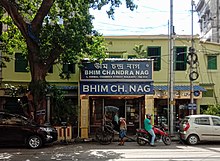
Several varieties of doi such as mishţi doi, fruit-floured doi like aam doi, custards, and rice pudding (khir or firni)[67] are also popular in West Bengal.
Shôndesh, chhanar jilapi, kalo jam, raghobshai, "pantua", "jolbhora shondesh",
Beverages
Common beverages include
Gallery
-
Panta bhat with Ilish Bhaja and Bhurta, popular Bengali New Year meal
-
Traditional Bengali Iftar Bazaar [69]
-
A very traditional meal of Bengal
-
A fancy arrangement of Bengali food
-
Bengali vegetarian meal
See also
- Bangladeshi cuisine
- List of Bangladeshi dishes
- List of Bengali spices
- Chaunk
References
- ISBN 9781925630831.
- ISBN 9781837580330.
- ISBN 9781107042810.
- ISBN 9780313324871.
- ^ Ghulam Murshid (2018). Bengali Culture Over a Thousand Years. Niyogi Books. p. 428.
- ^ Pearce, Melissa (10 July 2013). "Defining Bengali Cuisine: The Culinary Differences of West Bengal and Bangladesh". Culture Trip. Retrieved 1 September 2019.
- ^ a b c "Mughalnama: changing the contours of Mughlai cuisine in India". ANI. Retrieved 14 May 2022.
- ^ a b "All That You Ever Wanted To Know About Mughlai Cuisine!". culturalindia.net. Retrieved 1 September 2018.
- ^ Nair, Rukmini. "Are we what we eat?". Retrieved 28 November 2011.
- ^ Banerji, Chitrita (Winter 1995). "What Bengali Widows Cannot Eat". Granta (52). Archived from the original on 20 December 2011. Retrieved 28 November 2011.
- ^ a b "Food Habits". Banglapedia. Retrieved 10 March 2019.
- ^ a b c "Historical Sketch | Bengal Cuisine". bengalcuisine.in. Archived from the original on 8 March 2021. Retrieved 10 March 2019.
- ^ Pearce, Melissa (10 July 2013). "Defining Bengali Cuisine: The Culinary Differences of the Bengal Region". Culture Trip. Retrieved 10 March 2019.
- ^ "Our Food Their Food: A Historical Overview of the Bengali Platter | Sahapedia". sahapedia.org. Retrieved 10 March 2019.
- ^ "Coastal cuisines of Bangladesh". Dhaka Tribune. 24 March 2019. Retrieved 8 April 2019.
- ^ OL 30677644M. Retrieved 24 April 2024.
- ^ a b c d Fayeka Zabeen Siddiqua (10 October 2013). "Majestic Mezban". The Daily Star. Archived from the original on 4 August 2018. Retrieved 23 July 2019.
- ^ "Palate from the port". The Daily Star. 5 January 2016. Retrieved 12 July 2020.
- ^ Cambridge UniversityPress. pp. 210–215.
- ^ "The Nawabs of Dhaka And Their Regal Cuisine". KIXP. 26 February 2015. Retrieved 10 March 2019.
- ISSN 0971-751X. Retrieved 10 March 2019.
- ^ "Old Dhaka Bakarkhani – A Legendary Bread". 19 October 2013.
- ^ "Bakarkhani: delight in every bite". Daily Sun. 24 April 2016. Retrieved 17 September 2018.
- ^ Ara, Shifat (18 February 2014). "Gourmet Paan". The Daily Star (Bangladesh).
- ^ Mydans, Seth (8 July 1987). "For a secret stew recipe, time is running out". The New York Times. Retrieved 30 April 2015.
- ^ Chitty, Tom (8 November 2018). "Kolkata: A city of arts, culture and cuisine". cnbc.com. Retrieved 9 April 2019.
- ^ "Bengali Choshir Payesh Recipe | Choshir Paayesh". Debjanir Rannaghar. 13 January 2018. Retrieved 9 April 2019.
- ^ "Aamer Payesh Or Mango Rice Pudding Or Aam Kheer | PeekNCook". Moumita Ghosh Recipe Blog PeekNCook. Retrieved 9 April 2019.
- ^ "Calcutta Cuisine - Cuisine of Kolkata India - Bengali Traditional Food - What to Eat in Calcutta India". kolkata.org.uk. Retrieved 9 April 2019.
- ^ Dugar, Divya (12 June 2015). "Kolkata food: A dining guide to restaurants and dishes". CNN Travel. Retrieved 9 April 2019.
- ^ "Alexis Foundation". Archived from the original on 10 October 2019. Retrieved 10 October 2019.
- ^ "Is Odisha India's most underrated food destination?". Condé Nast Traveller India. 15 December 2017.
- ^ Mitra, Bishwabijoy. "Odia cooks to bring back forgotten Bengali recipes - Times of India". The Times of India.
- ^ "Bengali cuisine,Historical influences,Characteristics of Bengali cuisine,Cooking styles,Common Bengali Recipe Styles,Culinary Influences,Bengali meals,Mishţi (sweets),Snacks". beautifulbengal.com. Retrieved 27 September 2019.
- ^ hdl:10603/61925.
- ^ "Know All About The Famous Bengali Culinary Style Popular in the Eastern Part of the Indian Subcontinent". www.culturalindia.net. Retrieved 27 September 2019.
- hdl:10603/61925.
- ^ "Tandoori momo: how Tibetan refugees reshaped Indian cuisine". South China Morning Post. 9 July 2017. Retrieved 27 September 2019.
- ^ "Lip-Smacking Street Food Places in Kolkata That Should Be on Every Foodies List!". www.holidify.com. Retrieved 27 September 2019.
- ^ Deepak, Sharanya (27 April 2017). "Inside the Birthplace of Indian-Chinese Cuisine". Vice. Retrieved 27 September 2019.
- ^ a b c Chakravarti, Sudeep (December 2017). "A brief history of Adda—the Bengali fine art of discussion". Quartz India. Retrieved 17 February 2020.
- ISSN 0362-4331. Retrieved 17 February 2020.
- ^ ISBN 978-0-8223-2714-1.
- ^ Nevins, Debbie; Mariam, Whyte (15 July 2018). Bangladesh. Cavendish Square Publishing, LLC. p. 126.
- Cambridge UniversityPress.
- ^ WildFilmsIndia (19 February 2015), Women cut vegetables at a Bengali wedding in India, using a Boti or Dao, archived from the original on 17 November 2021, retrieved 31 March 2019
- ^ "www.CookingInIndia.com ~ Your Desi(Indian) Kitchen on the Net". 8 April 2008. Archived from the original on 8 April 2008. Retrieved 15 June 2019.
- ^ "Pots, Pans and Griddles - Gourmet Online". 14 October 2008. Archived from the original on 14 October 2008. Retrieved 15 June 2019.
- ^ a b "traditional indian cooking utensils - Indian Recipes, Indian Food and Cooking - FiveTastes.com". fivetastes.com. Retrieved 15 June 2019.
- ^ ISBN 978-1-57607-285-1.
- ^ a b McElroy, Linda. "Customs and Cuisine of Bangladesh | Dining for Women". Dining for Women. Retrieved 27 September 2019.
- ^ Scroope, Chara (2017). "Bangladeshi Culture - Etiquette". Cultural Atlas. Retrieved 27 September 2019.
Plates are taken to a main dish for serving rather than passing food around the table.
- ISBN 978-0-907325-79-6.
- ISBN 978-81-85692-24-1.
- JSTOR 10.1525/gfc.2010.10.3.58.
- ^ "History of Rossogolla". Retrieved 24 August 2015.
- ^ "The Origin of Rossogolla". Retrieved 24 August 2015.
- ^ "History of Rasgulla". Retrieved 24 August 2015.
- ^ "Sweet shops make hay in Diwali shine". The New Indian Express. 31 October 2013. Retrieved 18 February 2019.
- ISSN 0971-751X. Retrieved 18 February 2019.
- ^ "Dinkache ladoo, Gund ladoo, Gond Ladoo, Gond Ka Laddu.....Easy Recipes on CuisineCuisine.com". cuisinecuisine.com. Archived from the original on 22 April 2016. Retrieved 18 February 2019.
- ISBN 9780198038504.
- ISBN 9781569769546.
- ^ "Oatmeal Laddu". Living Foodz. Archived from the original on 2 May 2019. Retrieved 18 February 2019.
- ^ "Food Story: The journey of ladoo from a medicine to the much-loved Indian sweet". The Indian Express. 16 October 2014. Retrieved 18 February 2019.
- ISBN 978-93-5118-237-5.
- ^ "Notun Gurer Payesh/Traditional Bengali Rice Pudding | Remembering My Dida". IshitaUnblogged. 30 May 2012. Retrieved 18 February 2019.
- ISBN 978-1-903018-06-4.
- ^ "The iftar plates of Bangladesh". April 2023.
Further reading
- Ray, Krishnendu (2004). The migrant's table: meals and memories in Bengali-American households. Temple University Press. ISBN 1-59213-096-8. Retrieved 14 October 2011.











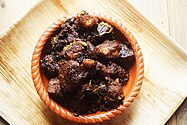







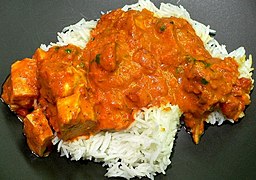
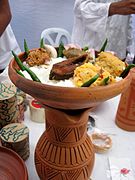
![Traditional Bengali Iftar Bazaar [69]](http://upload.wikimedia.org/wikipedia/commons/thumb/b/b2/Iftar_beguni.JPG/240px-Iftar_beguni.JPG)


